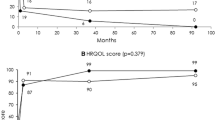Abstract
Purpose
To evaluate the clinical outcome for uterine adenomyosis with or without uterine leiomyomata 40 months after uterine artery embolization (UAE).
Methods
Forty women aged 39–56 years (median 46 years) with symptomatic uterine adenomyosis and magnetic resonance imaging findings of uterine adenomyosis with or without combined uterine leiomyomata underwent UAE. Self-perceived changes in clinical symptoms were assessed, and residual symptom severity and health-related quality of life (HRQOL) after UAE were evaluated. Clinical failure was defined as no symptomatic improvement or second invasive therapy after UAE. Results were stratified by the extent of uterine adenomyosis at baseline magnetic resonance imaging.
Results
Patients were followed for a median of 40 months (range 5–102 months). UAE led to symptomatic control after UAE in 29 (72.5%) of 40 patients while 11 women underwent hysterectomy (n = 10) or dilatation and curettage (n = 1) for therapy failure. No significant difference between women with pure uterine adenoymosis and women with uterine adenomyosis combined with uterine leiomyomata was observed. Best results were shown for UAE in uterine adenomyosis with uterine leiomyomata predominance as opposed to predominant uterine adenomyosis with minor fibroid disease (clinical failure 0% vs. 31.5%, P = 0.058). Throughout the study group, HRQOL score values increased and symptom severity scores decreased after UAE. Least improvement was noted for women with pure adenomyosis.
Conclusions
UAE is clinically effective in the long term in most women with uterine adenomyosis. Symptomatic control and HRQOL were highest in patients with combined disease of uterine adenomyosis but leiomyomata predominance.



Similar content being viewed by others
References
Matalliotakis IM, Kourtis AI, Panidis DK (2003) Adenomyosis. Obstet Gynecol Clin North Am 30:63–82
Ferenczy A (1998) Pathophysiology of adenomyosis. Hum Reprod Update 4:312–322
Bergeron C, Amant F, Ferency A (2006) Pathology and physiopathology of adenomyosis. Best Pract Res Clin Obstet Gynaecol 20:511–521
Dueholm M, Lundorf E, Hansen ES et al (2001) Magnetic resonance imaging and transvaginal ultrasonography for the diagnosis of adenomyosis. Fertil Steril 76:588–594
Bazot M, Cortez A, Darai E et al (2001) Ultrasonography compared with magnetic resonance imaging for the diagnosis of adenomyosis: correlation with histopathology. Hum Reprod 16:2427–2433
Reinhold C, McCarthy S, Bret PM et al (1996) Diffuse adenomyosis: comparison of endovaginal US and MR imaging with histopathologic correlation. Radiology 199:151–158
Ascher SM, Arnold LL, Patt RH et al (1994) Adenomyosis: prospective comparison of MR imaging and transvaginal sonography. Radiology 190:803–806
Dumousset E, Chabrot P, Rabischong B et al (2008) Preoperative uterine artery embolization (PUAE) before uterine myomectomy. Cardiovasc Intervent Radiol 31:512–520
Goodwin SC, Spies JB (2009) Uterine fibroid embolization. N Engl J Med 361:690–697
Katsumori T, Kasahara T, Kin Y et al (2007) Magnetic resonance angiography of uterine artery: changes with embolization using gelatine sponge particles alone for fibroids. Cardiovasc Intervent Radiol 30:398–404
Spies JB, Bruno J, Czeyda-Pommersheim F et al (2005) Long-term outcome of uterine artery embolization of leiomyomata. Obstet Gynecol 106(5 Pt 1):933–939
McCausland V, McCausland A (1998) The response of adenomyosis to endometrial ablation/resection. Hum Reprod Update 4:350–359
Jha RC, Takahama J, Imaoka I et al (2003) Adenomyosis: MRI of the uterus treated with uterine artery embolization. AJR Am J Roentgenol 181:851–856
Kim MD, Won JW, Lee DY et al (2004) Uterine artery embolization for adenomyosis without fibroids. Clin Radiol 59:520–526
Kitamura Y, Allison SJ, Jha RC et al (2006) MRI of adenomyosis: changes with uterine artery embolization. AJR Am J Roentgenol 186:855–864
Siskin GP, Tublin ME, Stainken BF et al (2001) Uterine artery embolization for the treatment of adenomyosis: clinical response and evaluation with MR imaging. AJR Am J Roentgenol 177:297–302
Lohle PN, De Vries J, Klazen CA et al (2007) Uterine artery embolization for symptomatic adenomyosis with or without uterine leiomyomas with the use of calibrated tris-acryl gelatin microspheres: midterm clinical and MR imaging follow-up. J Vasc Interv Radiol 18:835–841
Spies JB, Coyne K, Guaou Guaou N et al (2002) The UFS-QOL, a new disease-specific symptom and health-related quality of life questionnaire for leiomyomata. Obstet Gynecol 99:290–300
Gordts S, Brosens JJ, Fusi L et al (2008) Uterine adenomyosis: a need for uniform terminology and consensus classification. Reprod Biomed Online 17:244–248
Bazot M, Lafont C, Rouzier R et al (2009) Diagnostic accuracy of physical examination, transvaginal sonography, rectal endoscopic sonography, and magnetic resonance imaging to diagnose deep infiltrating endometriosis. Fertil Steril 92:1825–1833
Farquhar C, Brosens I (2006) Medical and surgical management of adenomyosis. Best Pract Res Clin Obstet Gynaecol 20:603–616
Fukunishi H, Funaki K, Sawada K et al (2008) Early results of magnetic resonance-guided focused ultrasound surgery of adenomyosis: analysis of 20 cases. J Minim Invasive Gynecol 15:571–579
Bratby MJ, Walker WJ (2009) Uterine artery embolisation for symptomatic adenomyosis—mid-term results. Eur J Radiol 70:128–132
Pelage JP, Jacob D, Fazel A et al (2005) Midterm results of uterine artery embolization for symptomatic adenomyosis: initial experience. Radiology 234:948–953
Kim MD, Kim S, Kim NK et al (2007) Long-term results of uterine artery embolization for symptomatic adenomyosis. AJR Am J Roentgenol 188:176–181
Daraï E, Coutant C, Bazot M et al (2009) Relevance of quality of life questionnaires in women with endometriosis. Gynecol Obstet Fertil 37:240–245
Conflict of interest
The authors declare that they have no conflict of interest.
Author information
Authors and Affiliations
Corresponding author
Rights and permissions
About this article
Cite this article
Froeling, V., Scheurig-Muenkler, C., Hamm, B. et al. Uterine Artery Embolization to Treat Uterine Adenomyosis with or without Uterine Leiomyomata: Results of Symptom Control and Health-Related Quality of Life 40 Months after Treatment. Cardiovasc Intervent Radiol 35, 523–529 (2012). https://doi.org/10.1007/s00270-011-0254-3
Received:
Accepted:
Published:
Issue Date:
DOI: https://doi.org/10.1007/s00270-011-0254-3




